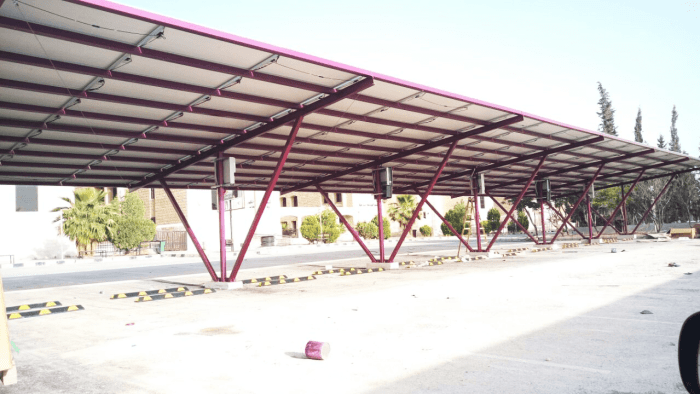 The Hashemite University environmental sustainability policy is focused on achieving sufficiency and sustainability through energy reduction practices, along with energy efficient approaches, building techniques, and electromechanical devices. These measures were employed in all of the new building expansion on campus (with more than 70,000 m2) of newly added building area. These practices are divided into categories: passive and active.
The Hashemite University environmental sustainability policy is focused on achieving sufficiency and sustainability through energy reduction practices, along with energy efficient approaches, building techniques, and electromechanical devices. These measures were employed in all of the new building expansion on campus (with more than 70,000 m2) of newly added building area. These practices are divided into categories: passive and active.
Passive Measures
Passive energy efficiency measures focus on harnessing the natural resources in the campus area to create comfortable conditions for the campus users, especially indoors, including the following techniques used throughout the campus:
- Building envelope and materials: The choice of building materials, thermal insulation, windows location and double glazing, accessibility and exit doors, were designed following universally leading green construction guidelines, with the objective of creating arid-region sustainable buildings; minimizing thermal swings inside the building through thermal insulation.
- Building Orientation: The location of buildings, landscape, and orientation took into consideration the movement of the sun, and wind direction in the area, allowing for creating thermally-acceptable living conditions in and around the buildings.
- Louvers and sun-breakers: south-facing windows were fitted with extruding louvers, which allows breaking the direct sunlight from entering the building during summer days, whereas allowing it to enter the building during winter days.
- Skylights: Skylights were extensively used throughout all campus buildings, allowing for diffused sunlight into the buildings, reducing the need for electricity and lighting, and creating natural ventilation cycles.
- Shading: Outdoor thermally acceptable areas were created using shading by building massing, photovoltaic solar canopies and carparks, cement canopies, and trees.
Active Measures
Active energy efficiency measures are those electromechanical techniques used to create comfortable living conditions for campus users, with focus on reducing the energy needs of these techniques. These used throughout the campus include the following:
- Lighting: All new buildings and construction use LED lights, which consumes less than 25% of the energy required by other fluorescent based light systems. Moreover, all the older buildings are being systematically retrofitted with LED light fixtures. LED in general provides higher luminesce and a better educational experience for the students.
- Heating, ventilation and air conditioning (HVAC): Energy efficient HVAC systems were used in the new construction buildings, including hybrid central and variable refrigerant flow (VRF) systems. These systems allow for responding to variable air conditioning needs, which decreases energy losses. Energy-efficient central and split unit systems are being retrofitted to the older building on-campus.
- Building-Integrated Controllers: Computer-based and processor-based sensors employed throughout the campus to allow for ambient light and temperature condition measurements, allowing for active, automatic control of lights and HVAC systems, reducing the need for manual intervention and reducing the energy requirements to run these systems.
Co-Author: Prof. Dr. Kamal Eddin Bani-Hani
Prof. Dr. Kamal Eddin Bani-Hani, is President of the Hashemite University since late 2011, Professor of Surgery, Hashemite University; Department of General Surgery and Specialized Surgery. He is leading a vision of economical, social, and environmental sustainability for the university. He received, on behalf of the Hashemite University, the Medal Order of Independence of the First Class for achievements in education and research. Among the many awards won, a couple of them is Aug 2011, Dr. Nabeeh Muammar Prize for the “Distinguished Physician” Award. In Apr 2009, Scopus-Elsevier award to honor contribution to science Award





